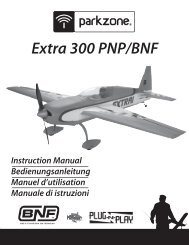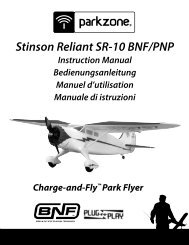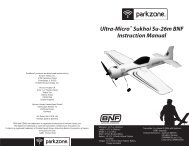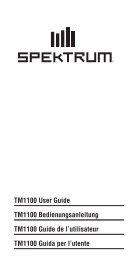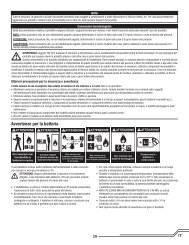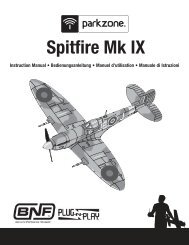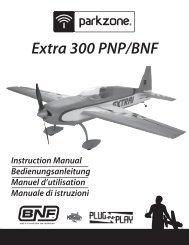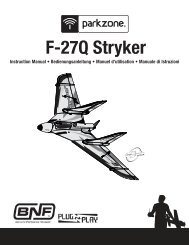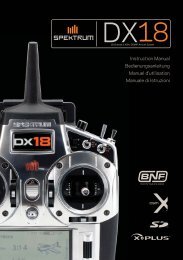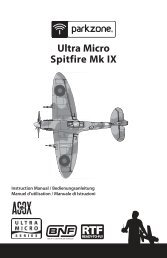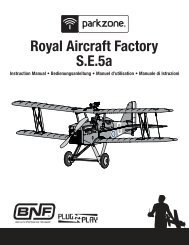Spitfire Mk IIB RTF - Horizon Hobby
Spitfire Mk IIB RTF - Horizon Hobby
Spitfire Mk IIB RTF - Horizon Hobby
Create successful ePaper yourself
Turn your PDF publications into a flip-book with our unique Google optimized e-Paper software.
Step 9<br />
Step 10<br />
Choosing a Flying Field<br />
• A large, open grassy field is required to fly your<br />
ParkZone ® <strong>Spitfire</strong> <strong>Mk</strong> <strong>IIB</strong>. Your <strong>Spitfire</strong> can achieve<br />
speeds greater than 60 km/h, so it covers ground fast.<br />
The choice of a large field will ensure greater success<br />
for your flight.<br />
• It is essential to have a minimum of 100 meters of<br />
clear space in all directions from the pilot.<br />
• Make certain that you do not fly near trees, buildings,<br />
or other areas that can restrict your view or interfere<br />
with your flying. NEVER fly near streets, parking lots,<br />
or people.<br />
200m<br />
WIND<br />
VENT<br />
VIENTO<br />
Optimal Flying Conditions<br />
You want to fly! However, you need to make sure that you<br />
fly in the conditions that will allow you to have the best<br />
success. This is when there is little to no wind (less than<br />
13 km/h).<br />
To check wind conditions:<br />
1. Tie the included red ribbon to the transmitter antenna.<br />
2. Hold the transmitter antenna so it is parallel to the<br />
ground and note how much the ribbon moves in the<br />
wind. If the ribbon hangs down, conditions are perfect<br />
to fly. There is some variance in the amount of wind<br />
that you can fly in, but if the angle between the antenna<br />
and the ribbon, when the antenna is parallel to the<br />
ground, is less than 20 degrees, it is too windy to fly.<br />
<br />
Français<br />
Stade 10. Conditions Optimales de Volr<br />
Français<br />
Stade 9. Choix du Terrain<br />
Vous voulez voler ! Si vous attendez que les conditions météo soient correctes, vous prendrez plus de plaisir. Pour vos<br />
premiers vols, un vent nul est conseillé.<br />
• Un grand champ recouvert d’herbe est le meilleur choix. Votre <strong>Spitfire</strong> <strong>Mk</strong> <strong>IIB</strong> vole à environ 60 km/h et parcourt donc une<br />
grande distance rapidement. Le champ doit être le plus grand possible.<br />
• Il est primordial d’avoir au minimum 100 mètres d’espace libre dans toutes les directions autour du pilote.<br />
• Ne pas voler à proximité d’arbres, d’édifices et de tout obstacle qui pourraient vous cacher le modèle ou interférer avec le<br />
vol. NE JAMAIS voler prés des rues, des parkings ou du public.<br />
Pour vérifier la vitesse du vent:<br />
1. Attacher le drapeau fourni à l’extrémité de l’antenne de l’émetteur.<br />
2. Tenir l’émetteur pour que l’antenne soit parallèle au sol et noter comment le drapeau flotte avec le vent. Si le drapeau<br />
pend vers le bas, les conditions de vol sont excellentes. Si l’angle entre l’antenne et le drapeau est inférieur à 20<br />
degrés, il y a trop de vent pour un pilote peu expérimenté.<br />
Italiano<br />
Passo 9. Scelta del Campo di Volo<br />
Italiano<br />
Passo 10. Condizioni di Volo Ottimali<br />
• Per volare serve un grande prato spazioso. Il <strong>Spitfire</strong> <strong>Mk</strong> <strong>IIB</strong> vola a più di 60 km/h e quindi si sposta velocemente. Più grande è il<br />
campo, meglio è. Scegliere un ampio spiazzo erboso.<br />
• E’ essenziale disporre di almeno 100 metri di spazio libero in ogni direzione.<br />
• Non volare sopra o vicino alle persone, linee elettriche, strade, ferrovie, veicoli, alberi, ghiaia, superfici dure o oggetti sui quali non si<br />
desidera entrare in collisione. MAI VOLARE in prossimità delle persone, strade o parcheggi.<br />
Español<br />
Paso 9. Selección de un Campo de Vuelo<br />
• Para volar su <strong>Spitfire</strong> <strong>Mk</strong> <strong>IIB</strong> de ParkZone ® es necesario hacerlo en un campo de hierba amplio y despejado. Su <strong>Spitfire</strong> puede alcanzar<br />
velocidades superiores a 60 km/h, por lo que recorre distancias rápidamente. Cuanto más grande sea el campo mejor.<br />
• Es importante contar por lo menos con 100m de espacio abierto en todas direcciones desde el punto del piloto.<br />
• Asegúrese de no volar cerca de árboles, edificios u otras áreas que pueden limitar su visión o interferir con el vuelo.<br />
NUNCA vuele cerca de calles, estacionamientos o personas.<br />
Vuoi volare! Sii paziente, hai bisogno che ci siano le condizioni che ti permettano di avere il migliore successo. Ciò si<br />
verifica quando c’è poco vento (meno di 13 km/h).<br />
Per misurare l’intensità del vento:<br />
1. Annoda il nastro rosso in cima all’antenna della trasmittente.<br />
2. Tenere la trasmittente in modo che l’antenna sia parallela al terreno e notare come si sposta il nastro a causa del<br />
vento. Se il nastro pende verticalmente le condizioni per volare sono perfette. Se invece l’angolo tra l’antenna ed<br />
il nastro è meno di 20° significa che c’è troppo vento per volare.<br />
Español<br />
Paso 10. Condiciones de Vuelo Óptimas<br />
Usted quiere volar. Sin embargo, debe comprobar que vuela en las condiciones que le permitirán tener el mayor éxito.<br />
Esto sucederá cuando haya muy poco o nada de viento (menos de 13 km/h).<br />
Para comprobar las condiciones de viento:<br />
1. Ate la cinta roja suministrada a la antena del transmisor.<br />
2. Ponga la antena del transmisor en posición paralela al suelo y observe cómo se mueve la cinta con el viento. Si la<br />
cinta queda inerte, las condiciones del tiempo son buenas para volar. Existe una variante en cuanto la potencia de<br />
viento con la que puede volar, pero si el ángulo entre la antena y la cinta es inferior a 20°, el viento es demasiado<br />
fuerte para volar.<br />
20 21



